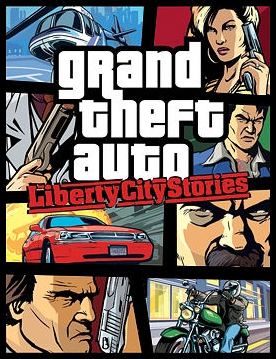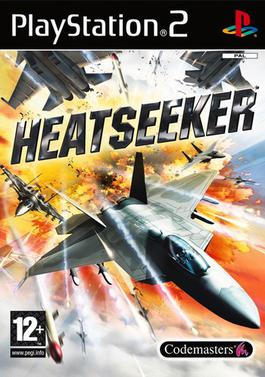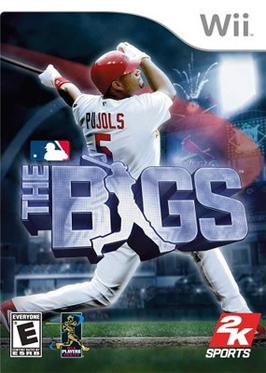
Lumines: Puzzle Fusion is a 2004 puzzle game developed by Q Entertainment and published for the PlayStation Portable by Bandai in Japan and by Ubisoft elsewhere. The objective of the game is to arrange descending two-colored 2×2 blocks to create 2×2 squares of matching color. A vertical line known as the "time line" sweeps across the field, erases completed squares, and awards points. Each stage has a skin that affects the background, block colors, music, and the speed of the time line.

Grand Theft Auto: Liberty City Stories is a 2005 action-adventure game developed in a collaboration between Rockstar Leeds and Rockstar North, and published by Rockstar Games. The ninth installment in the Grand Theft Auto series, it was initially released as a PlayStation Portable exclusive in October 2005. A port for the PlayStation 2 was later released in June 2006. At the time of release, the recommended retail price of the PS2 port was around half the price of the PSP version, because the PS2 version does not feature the custom soundtrack ripping capability of the PSP version. Ports for iOS, Android and Fire OS devices were also released in December 2015, February 2016, and March 2016, respectively.

Archer Maclean's Mercury is a 2005 puzzle-platform game for the PlayStation Portable developed by the eponymous British game programmer, Archer Maclean and Awesome Studios. In Mercury, the goal is to guide a drop of mercury to its appointed destination by tilting the stage, in a similar fashion to Super Monkey Ball. Levels come in different varieties that prioritize different methods of completing each level. The game was conceived when Archer Maclean used a previous minigame from Jimmy White's Cueball World and added a liquid metal physics. It was originally designed to have motion controls by using a tilt sensor peripheral for the PSP but was never released due to technical constraints.

Test Drive Unlimited is a 2006 racing video game developed by Eden Games and published by Atari for Xbox 360 and Microsoft Windows. Atari Melbourne House developed the PlayStation 2 and PlayStation Portable versions. Being the eighteenth entry in the Test Drive series, Unlimited serves as a reboot of the franchise, discarding the continuity of the previous games. The game features over 125 licensed sports cars and motorcycles and the terrain is modeled after the Hawaiian island of Oʻahu that features some 1,000 miles (1,600 km) of roads and highways.

Ridge Racer, released in Japan as Ridge Racers, is an arcade racing video game developed by Namco for the PlayStation Portable. It is named after the eponymous Ridge Racer video game series to which it belongs. The game was released in Japan on 12 December 2004, in North America on 24 March 2005, and in Europe and Australia on 1 September as a launch title. Available in the game is a fully playable version of the Namco arcade game New Rally-X.

Madden NFL 07 is an American football video game based on the NFL that was published by EA Sports and developed by EA Tiburon. It is the first in the video game series to debut for the PlayStation 3 and Wii consoles as launch titles and the last Madden game to be released on the Game Boy Advance. Former Seattle Seahawks running back Shaun Alexander is on the cover.

Tomb Raider: Anniversary is an action-adventure video game developed by Crystal Dynamics and Buzz Monkey Software and published by Eidos Interactive in 2007 for Microsoft Windows, PlayStation 2, Xbox 360, PlayStation Portable, Wii and mobile phones. It was later ported to OS X in 2008 and PlayStation 3 in 2011. The eighth overall entry in the Tomb Raider series and second in the Legend trilogy, Anniversary is a remake of the first Tomb Raider game, originally released in 1996.

Heatseeker is a combat flight simulator video game for the Wii, PlayStation 2, and PlayStation Portable game systems jointly developed by IR Gurus and Codemasters.

Little Britain: The Video Game is a collection of mini-games by British studios Gamerholix and Gamesauce and published by Mastertronic Group under their Blast! Entertainment label. It is presented in the format of an episode from the TV show. Players can interact with the sketch show characters in a series of seven mini-games featuring Lou and Andy, Vicky Pollard, Emily and Florence, Marjorie Dawes, Daffyd Thomas, Judy & Maggie and Letty. Each mini game plays like a sketch from the TV show and to win the game, the player must progress through all the sketches to the end of the show, where the credits will roll. The game's reception was generally negative, and it has appeared on several lists as one of the worst games ever made.

The Bigs is an arcade-style baseball video game for the Xbox 360, PlayStation 3, PlayStation 2, Wii and PlayStation Portable. It was released in June 2007 in North America, and in October in the PAL region. A sequel, The Bigs 2, was released on July 7, 2009.

Ratatouille is a 2007 platform video game developed by Heavy Iron Studios and published by THQ. It is based on the Pixar animation film of same name.

Medal of Honor Heroes 2 is a first-person shooter video game for the Wii and the PlayStation Portable. It is the 12th installment in the long-running Medal of Honor series of World War II games, and a direct sequel to the PSP-exclusive Medal of Honor: Heroes, released a year prior. Each version was built from the ground up for its respective system. The Wii version was announced at Nintendo's E3 2007 Press Conference on July 11, 2007. Medal of Honor: Heroes 2 is set in World War II, starting on the Normandy beaches trying to control German bunkers and then move on to secure a village in France.

The Sims 2: Castaway is the third console spin-off of the life simulation video game The Sims 2 for the Wii, Nintendo DS (NDS), PlayStation 2 (PS2) and PlayStation Portable (PSP). It is also available on mobile phones; Nokia offered Castaway on the Ovi Store. A roughly similar game, The Sims Castaway Stories, is available for personal computers, but is not a direct port of Castaway.

Thrillville: Off the Rails is a theme park simulation video game developed by Frontier Developments and published by LucasArts. It is the sequel to the 2006 game Thrillville. The game was released worldwide in October 2007.

Dragon Ball Z: Budokai Tenkaichi is a series of fighting games developed by Spike based on the Dragon Ball manga series by Akira Toriyama. The series was published by Namco Bandai Games under the Bandai brand name in Japan and Europe, and as Atari in North America and Australia from 2005 to 2007. Atari's PAL distribution network was absorbed into Bandai Namco Partners and Bandai Namco has also handled publishing in North America for future Dragon Ball Z games since 2010, effectively ending Atari's involvement.

Toy Story 3 is a 2010 platform game developed by Avalanche Software and published by Disney Interactive Studios. The game is based on the 2010 film of the same name. It was released for PlayStation 3, Xbox 360, Wii, and Microsoft Windows. The game was ported to OS X by TransGaming. A Nintendo DS version was developed by n-Space, while Disney Mobile Studios developed and published an iOS game based on the film. Another version was developed by Asobo Studio and released for PlayStation 2 and PlayStation Portable.

Mercury Hg is a puzzle-platform game developed by British studio Eiconic Games and published by UTV Ignition Games. It is the third entry in the Mercury series. The goal is to navigate a blob of mercury to a goalpost by tilting the stage without losing all of the mercury. The mercury can be split apart into multiple blobs, change colors using Paintshops, and be remerged into a new color. In addition, the game utilizes an online leaderboard, ghost sharing, and the ability to insert music into the levels.
Guilty Gear X2 is a 2D fighting video game developed by Arc System Works, and published by Sammy Studios. It was first released on May 23, 2002 for Japanese arcades, and later ported to the PlayStation 2 for North America in 2003. The game received updated versions for several platforms, each containing various adjustments: Guilty Gear X2 #Reload (2003), Guilty Gear XX Slash (2005), Guilty Gear XX Accent Core (2006), Guilty Gear XX Accent Core Plus (2008), and Guilty Gear XX Accent Core Plus R (2012).

Off Road is a 2008 racing video game developed by Razorworks and published by Xplosiv. It is the seventh and final game of the Ford Racing series. It is also the only game in the series to feature vehicles by Land Rover, which was owned by Ford Motor Company at the time. The game was released for the personal computer (PC), PlayStation 2 (PS2), PlayStation Portable (PSP), and the Nintendo Wii. The game received mostly negative reviews.


















